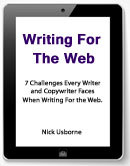And the secret to writing an open-ended headline is…

If you’re not totally into writing great headlines, you should be.
When you’re writing online, headlines are everywhere.
Actually, anything you write that’s 15 words or less should be treated like a headline.
Headlines for blog posts, articles, reviews, buyers’ guides and even homepages.
For email subject lines. Same for e-newsletters. Headings within those emails and e-newsletters.
Tweets. Titles for Facebook updates. Bios for Instagram.
Whenever you’re short-form writing online, you’ll do well to think “headline”.
And just one of the things to understand about headlines is the difference between those that are closed and those that are open.
Here are examples of each.
First, a version of a headline that is closed…
> Drinking a glass of milk a day is good for you.
It’s just a statement. A claim. I read it and think. “Hmm, OK. Maybe that’s true.”
But do I feel compelled to keep reading? Do I feel a sudden and urgent need to discover why milk might be good for me? No. Because this is a closed headline. It’s self-contained. It included both the question and the answer. Is milk good for me? Yes, it is. There is no reason for me to keep treading.
Now let’s look at a version that is open ended…
> Why your grandmother told you to drink this every day.
This is the open-ended version of a headline for the exact same article or post.
But this time I don’t try to tell the whole story in the headline.
This time I am trying to get you hooked and intrigued.
Heck, I’m even getting you to think about your grandma and whether or not there was anything she told you to drink each day.
Am I being a little manipulative here? Sure I am. But in a totally harmless way. I’m just being playful.
And beyond the playfulness, I’m also doing my job.
Because my job is to write a headline that gets as many people as possible to read the body of the page or screen.
And I can’t get people to keep reading if my headlines are closed. They have to be open-ended. They have to deliver just a teeny part of the answer, or maybe no part of it at all.
Writing open-ended headlines isn’t so hard.
Go to a few of your favorite blogs and news sites. Cut and past 50 headlines into a text document. Read through them and identify which headlines are closed and which are open-ended.
With the closed one, write a new version or two.
Get into the habit.
Make it a good habit, and you’ll soon start writing much better headlines, email subject lines, tweets, Facebook updates and so on.
The web is filled with opportunities to write lines of 15 words or less.
Make the most of them.
NOTE: I have a new course on optimizing digital headlines coming soon. In the meantime, for more on web content creation and optimization, check out my course, Web Content Optimization.

If you found this post helpful, sign up for my e-newsletter and get a free copy of my 35-page guide…
Writing For The Web #1 — 7 Challenges every Writer and Copywriter faces when writing for the Web.
Sign up and I’ll send you the link for the download, and then you’ll receive my most recent post as part of my e-newsletter every Tuesday morning.
Sign Up for my Excess Voice Newsletter…
Name:
Email:
0 subscribers
We respect your privacy
Email Marketing by GetResponse
(Your email address will be used only for the purpose of sending you this newsletter, and you’ll be free to unsubscribe at any time.)
The post And the secret to writing an open-ended headline is… appeared first on Writing for the web - online copywriting and content writing..
Nick Usborne's Blog
- Nick Usborne's profile
- 6 followers




